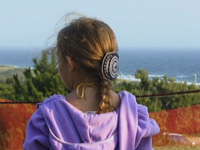
Grades 10 - 12, College, Adults
Directed by Anne Makepeace
Produced by Anne Makepeace Productions
DVD Purchase $258, Rent $83
US Release Date: 2011
Copyright Date: 2010
DVD ISBN: 1-59458-805-8
Subjects
American Studies
Anthropology
Community
Geography
Global Issues
History
Indigenous Peoples
Linguistics
Multicultural Studies
Native Americans
Sociology
Women's Studies
Awards and Festivals
National PBS Broadcast on "Independent Lens"
Inspiration Award, Full Frame Documentary Film Festival
Moving Mountains Prize, Mountainfilm in Telluride
Society for Visual Anthropology Film and Interactive Media Festival
American Documentary Showcase
Margaret Mead Film Festival
Big Sky Documentary Film Festival
Stranger than Fiction Series, IFC Center, NYC
Santa Barbara International Film Festival
Environmental Film Festival in the Nation's Capital
Maine International Film Festival
Martha's Vineyard Film Festival
Woods Hole Film Festival
Nantucket Film Festival
Boston Independent Film Festival
Vail Film Festival
Beeld voor Beeld Documentary Film Festival
Provincetown Film Festival
Berkshire International Film Festival
Litchfield Hills Film Festival
Tells the amazing story of the return of the Wampanoag language, a language that was silenced for more than a century.
Original Price for Educational Rights: $295 - Special Discounted Price: $258
 |
"There is nothing I know of that's anything like the Wampanoag case." Noam Chomsky, Professor Emeritus of Linguistics, MIT |
Celebrated every Thanksgiving as the Indians who saved the Pilgrims from starvation, and then largely forgotten, the Wampanoag Tribes of Cape Cod and Martha's Vineyard are now saying loud and clear, and in their Native tongue, "As Nutayune‚n," - We Still Live Here.
The Wampanoag's ancestors ensured the survival of the English settlers known as the Pilgrims, and lived to regret it. Now a cultural revival is taking place. Spurred on by their celebrated linguist, Jessie Little Doe Baird, recent winner of a MacArthur `genius' award, the Wampanoag are bringing their language home.
Like many Native American stories, this one begins with a vision. Years ago, Jessie began having recurring dreams: familiar-looking people from another time speaking in an incomprehensible language. These visions sent her on an odyssey that would uncover hundreds of documents written in Wampanoag, lead her to a Masters in Linguistics at MIT, and result in an unprecedented feat of language reclamation by her people. Jessie's daughter Mae is the first Native speaker of Wampanoag in a century.
Other films by Anne Makepeace are Coming to Light: Edward S. Curtis and the North American Indians, Rain in a Dry Land, and I.M. Pei: Building China Modern.
Reviews
"Seeing We Still Live Here is a moving and instructive experience. The film captures the emotion of the Wampanoag as they recover their language, which has deep significance for them. This success story of bringing a language back to life will inspire others attempting to revive or revitalize their heritage languages."
"A wonderfully told, spirited story of the Wampanoag, whose language had not been spoken fluently for at least a century, rebuilding it--as well as culture and history--word by word from centuries-old written texts...This kind of revival has been taking place across Turtle Island (North America), but it is told here with special elegance, amazing animation, and a personal edge that will, at first, evoke tears of tragedy and rage for a people reduced nearly to nothing. The culture is then reborn in the happy faces of children speaking words that had been silent for generations."
"A beautiful film. The content is solid and is appropriate for any educational setting. It weaves a good story by focusing on Jessie Little Doe but also gives the broader picture of language revival efforts by the Wampanoag people...I highly recommend this film."
"According to the National Geographic Society's Enduring Voices Project by the year 2100 half of the world's some 7,000 language may no longer be spoken by anyone. Anne Makepeace's award-winning film We Still Live Here (As Nutayune‚n) chronicles Jessie Little Doe Baird and her colleagues using documents written long ago to revive their ancestral language. Their success gives hope to other Native peoples who have lost or are losing treasured ways of life and their precious languages."
"A beautiful film about a fascinating subject...Truly remarkable, and Makepeace captures it with gorgeous cinematography."
"This a film that should be shown to students studying languages - any of them - because it shows the power of language and the gift of learning one. I challenge you not to want to pick up a language class after seeing this film."
"For all that the linguistics and history are interesting and tragic, the film in many way shines because of what we see of the Wampanoag people. The film spends the most time with Jesse Littledoe Baird, who makes for an endearingly unlikely heroine - a middle-aged wife and mother whose passion leads her to do something truly extraordinary."
"Language, heavy muscles in our backsides that hold us erect and opposable thumbs...these are the three elements, some anthropologists contend, that made human evolution possible. Of these three, spoken language most distinguishes us from other species. So what, then, is lost when a language dies? No less than cultural identity, tradition and subtle information about the environment in which that culture existed."
"Anne Makepeace's extraordinary film documents the origin and continued efforts of the WŰpan‚ak Language Reclamation Project. The indigenous Wampanoag Nation of southeastern Massachusetts is noted for aiding the Pilgrims after their arrival in the so-called 'New World' four centuries ago. That foreign invasion ultimately resulted in the rapid decline of their once-thriving culture. The tribes lost their lands and became subject to the laws of the dominant culture, and soon their language began to recede as the native-speaker population dwindled in the years following the American Revolution."